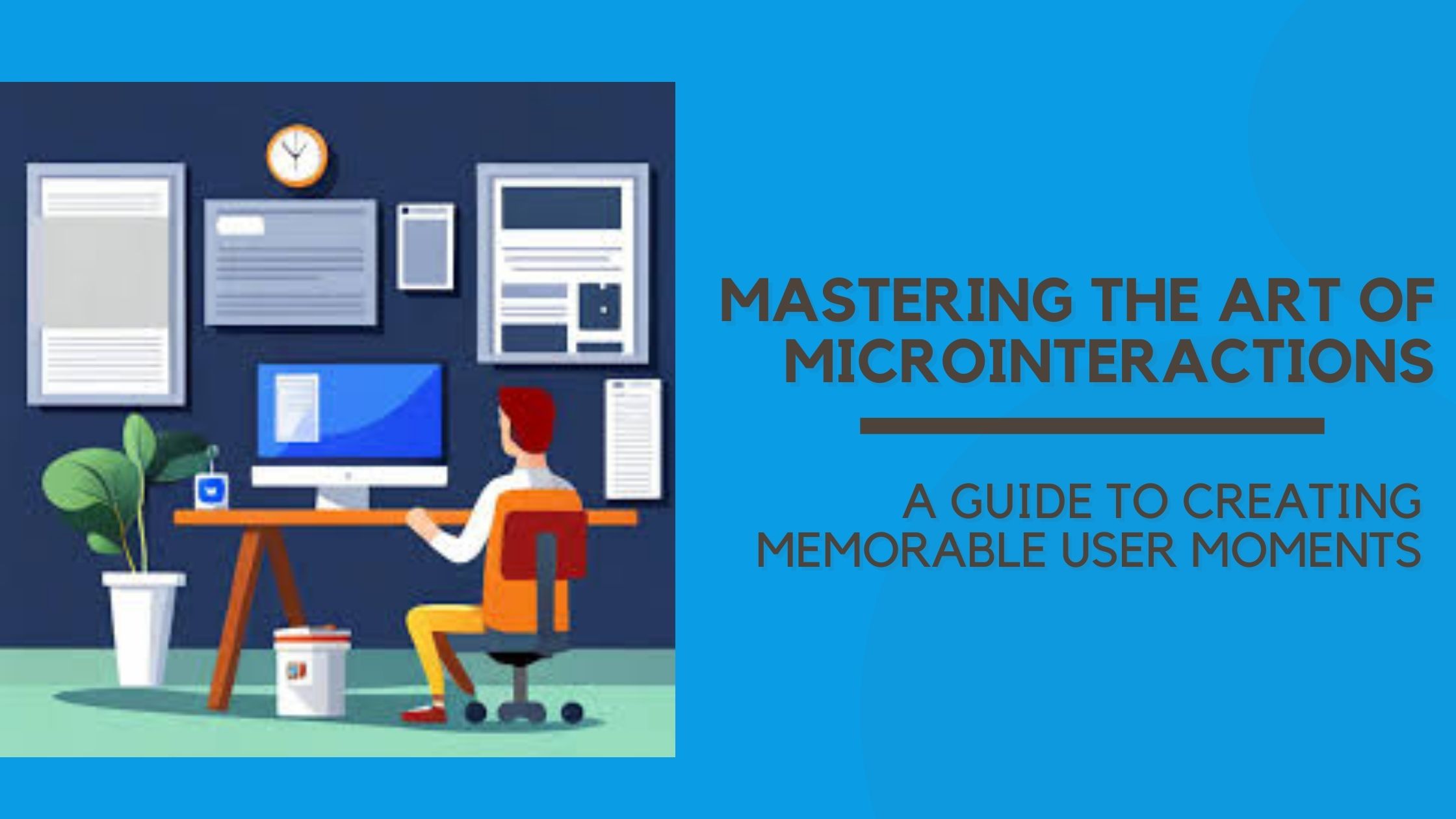Mastering the Art of Microinteractions: A Guide to Creating Memorable User Moments
In a digital world overflowing with noise and distractions, it’s often the smallest details that leave the biggest impressions. Enter microinteractions: those subtle yet powerful design elements that can transform a mundane user experience into something truly memorable. Whether it’s the gentle vibration of your phone when you receive a notification or the satisfying animation that accompanies a successful form submission, these fleeting moments hold the key to engaging users on a deeper level. In this guide, we’ll delve into mastering the art of microinteractions—unpacking what they are, why they matter, and how you can craft delightful experiences that resonate long after users have clicked away. Get ready to elevate your designs and create unforgettable moments that keep users coming back for more!
What Are Microinteractions?
Microinteractions might sound like a buzzword, but they play a crucial role in shaping how users engage with your product. These tiny moments of interaction often go unnoticed, yet they can make or break the overall user experience. Think about it: that satisfying button click, the smooth transition between screens, or even the gentle pulsating notification. Each of these elements contributes to an intuitive and enjoyable interface. As we dive deeper into this guide on mastering microinteractions, you’ll discover why they’re essential for creating memorable user experiences. You’ll learn actionable tips for designing effective interactions and explore real-world examples that illustrate their power. Whether you’re building an app or refining a website, understanding microinteractions is key to connecting with your audience on a deeper level and enhancing usability.
The Importance of Microinteractions in User Experience
Microinteractions play a crucial role in shaping user experience. They are the subtle animations or feedback that occur during interactions, like a button changing color when hovered over or a loading spinner.
These small details create an emotional connection between users and interfaces. When executed well, microinteractions can enhance usability by guiding users through tasks seamlessly.
They also contribute to brand identity. Unique and thoughtful designs can leave lasting impressions, making your application memorable. Users often remember how they felt while using a product, not just its functionality.
Moreover, microinteractions help reduce cognitive load. Clear visual cues inform users about what actions to take next without overwhelming them with information.
Designing Effective Microinteractions: Tips and Best Practices
When designing microinteractions, clarity is key. Users should instantly understand what action they’ve taken and the reaction that follows. Simple animations can effectively communicate this.
Keep it subtle. Overly flashy designs can distract rather than engage users. Aim for smooth transitions that feel natural within the overall interface.
Consistency builds familiarity. Use similar styles, colors, and motions across your app or website to create a cohesive experience. This not only enhances usability but also reinforces brand identity.
Timing matters too; consider how long an animation lasts and when it occurs in relation to user actions. Shorter animations generally feel more responsive, while longer ones may be appropriate for loading screens or status updates.
Lastly, gather feedback from real users during testing phases. Understand their reactions and adjust accordingly to make sure those small moments truly resonate with them.
Examples of Successful Microinteractions
One notable example of successful microinteractions is the subtle animations seen in notification alerts on mobile devices. When you receive a message, the slight bounce or fade effect captures attention without overwhelming the user. It feels natural and engaging.
Another instance can be found in e-commerce websites during checkout processes. A progress indicator showing completed steps enhances clarity and reduces anxiety, guiding users smoothly through their purchase journey.
Consider social media platforms as well. The heart icon animation when liking a post creates an emotional response that reinforces connection with content creators.
Lastly, Spotify’s play button transforms visually when pressed, providing instant feedback to users while enhancing satisfaction through delightful interaction design. Each of these examples demonstrates how thoughtful microinteractions elevate user experience significantly.
Best Practices for Microinteractions
To ensure that your microinteractions are effective, keep these best practices in mind:
1. Be Consistent
Consistency in design helps users predict how interactions will behave. Use similar animations, colors, and sounds across your product to create a cohesive experience.
2. Prioritize Accessibility
Design microinteractions with accessibility in mind. Ensure that visual cues are accompanied by auditory feedback or text descriptions for users with disabilities.
3. Optimize for Performance
Microinteractions should not hinder performance. Ensure that animations are smooth and do not cause delays or lags, as this can frustrate users.
4. Balance Animation and Functionality
While animations can enhance user experience, excessive motion can be distracting. Strive for a balance that maintains functionality while adding a layer of enjoyment.
5. Stay Updated with Trends
User expectations evolve, and so do design trends. Stay informed about emerging design patterns and user interface innovations to keep your microinteractions fresh and engaging.
Common Mistakes to Avoid when Implementing Microinteractions
Microinteractions can enhance user experience, but missteps are common. One major mistake is overloading users with too many animations. While it’s tempting to add flair, excessive movements can confuse or frustrate.
Another pitfall is neglecting context. Microinteractions should align with the task at hand. When they feel out of place, they disrupt rather than assist the user journey.
Also, consider responsiveness. If a microinteraction lags or fails on certain devices, it detracts from usability. Users expect seamless interactions across all platforms.
Ignoring accessibility guidelines is another error that limits your reach. Ensure that everyone can enjoy these moments by incorporating alternative text and keyboard navigation options.
Lastly, don’t forget to test your designs thoroughly. Skipping this step may lead to overlooked issues that compromise user engagement and satisfaction.
The Future of Microinteractions in UX Design
The future of microinteractions in UX design is poised for exciting innovations. As technology evolves, so do the possibilities for enhancing user experiences through these small yet impactful design elements.
With advancements in artificial intelligence and machine learning, we can expect microinteractions to become more personalized. Imagine a digital interface that learns from user behavior and tailors feedback or notifications accordingly.
Moreover, as voice interfaces gain popularity, microinteractions will likely adapt to auditory cues. This shift could redefine how users engage with applications, making interactions seamless and intuitive without relying solely on visual prompts.
Augmented reality (AR) also holds promise for enriching microinteractions. By integrating real-world contexts into digital experiences, designers can create engaging moments that resonate deeply with users.
As brands prioritize emotional connections with their audience, microinteractions will play a crucial role in fostering these relationships by delivering delightful surprises at every turn.
Conclusion: How to Take Your UX Design to the Next Level with Microinteractions
Microinteractions are more than just small design elements; they represent the subtle art of engaging users at critical moments. By incorporating well-crafted microinteractions, you can transform a mundane experience into something memorable and delightful.
To elevate your UX design, focus on understanding user needs and behaviors. Tailor microinteractions that resonate with your audience’s expectations while enhancing usability. Always keep testing and iterating based on user feedback to refine these interactions further.
Embrace creativity in every detail—whether it’s a playful animation or an informative alert—and remember that even tiny features can leave lasting impressions. As technology evolves, so will the possibilities for microinteractions in creating meaningful connections between users and products.
By mastering this art form, you’ll not only improve engagement but also build trust with your audience, fostering loyalty over time. The impact of thoughtful microinteractions extends far beyond aesthetics; they’re essential tools for any designer looking to create exceptional user experiences.




